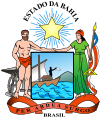 Former imperial coat of arms of Brazil | |
| Heraldic tradition | Portuguese |
|---|---|
| Governing body | Cartório de Nobreza e Fidalguia (1808-1889) |
Brazilian heraldry as a distinct form of heraldry dates to 1822, when Brazil became independent as an Empire, under the reign of the House of Braganza. Being formerly a part of the Portuguese Empire and being ruled by the same Royal House that reigned in Portugal, Brazilian heraldry followed the tradition of Portuguese heraldry.













































